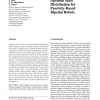Free Online Productivity Tools
i2Speak
i2Symbol
i2OCR
iTex2Img
iWeb2Print
iWeb2Shot
i2Type
iPdf2Split
iPdf2Merge
i2Bopomofo
i2Arabic
i2Style
i2Image
i2PDF
iLatex2Rtf
Sci2ools
IJRR
2006
2006
Optimal Mass Distribution for Passivity-Based Bipedal Robots
This paper reports how and to what extent the mass distribution of a passive dynamic walker can be tuned to maximize walking speed and stability. An exploration of the complete parameter space of a bipedal walker is performed by numerical optimization, and optimal manifolds are found in terms of speed, the form of which can be explained by a physical analysis of step periods. Stability, quantified by the minimal basin of attraction, is also shown to be high along these manifolds, but with a maximum at only moderate speeds. Furthermore, it is examined how speed and stability change on different ground slopes. The observed dependence of the stability measure on the slope is consistent with the interpretation of the walking cycle as a feedback loop, which also provides an explanation for the destabilization of the gait at higher slopes. Regarding speed, an unexpected decrease at higher slopes is observed. This effect reveals another important feature of passive dynamic walking, a swing-b...
| Added | 13 Dec 2010 |
| Updated | 13 Dec 2010 |
| Type | Journal |
| Year | 2006 |
| Where | IJRR |
| Authors | Joachim Haß, J. Michael Herrmann, Theo Geisel |
Comments (0)

